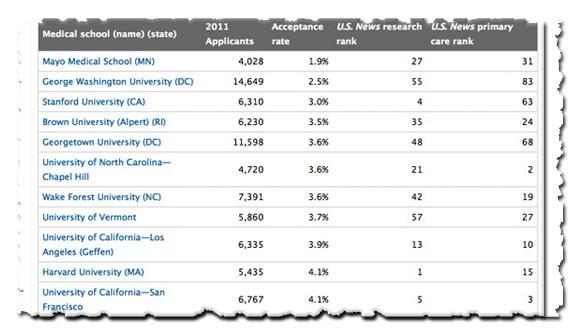Exploring the Most Selective Medical Schools in the United States: Insights and Strategies
Medical Schools with the Lowest Acceptance Rates: A Closer Look
Entering medical school remains one of the most demanding academic challenges, especially as healthcare careers grow increasingly sought after. Recent statistics from U.S. News & World Report reveal that a handful of U.S. medical schools maintain acceptance rates below 4%, highlighting their elite status and the fierce competition applicants face. This article delves into the 20 medical schools with the most stringent admissions, providing prospective students and educators with a comprehensive understanding of the barriers and expectations in today’s medical education environment.
Leading Medical Schools with the Most Stringent Admissions
Admission to the country’s top medical institutions demands more than just outstanding academic records and strong recommendations. These schools often accept fewer than 3 out of every 100 applicants, reflecting the intense demand for limited enrollment slots. Prestigious universities such as Harvard Medical School, Johns Hopkins University, and Stanford University are renowned not only for their academic rigor but also for their contributions to medical research and innovation. Candidates undergo thorough evaluations that assess academic excellence, research involvement, leadership experience, and personal qualities like perseverance and empathy.
Noteworthy Medical Schools with Rigorous Entry Requirements
- Harvard Medical School ‚ÄĒ Celebrated for pioneering medical research and clinical training
- Johns Hopkins University School of Medicine ‚ÄĒ A leader in medical education and patient-centered care
- Stanford University School of Medicine ‚ÄĒ Known for fostering interdisciplinary medical innovation
- University of California, San Francisco ‚ÄĒ At the forefront of public health and biomedical research
- Columbia University Vagelos College of Physicians and Surgeons ‚ÄĒ Distinguished by its comprehensive and diverse curriculum
| Institution | Acceptance Rate | Average MCAT Score | Average GPA |
|---|---|---|---|
| Harvard Medical School | 3% | 519 | 3.9 |
| Johns Hopkins University | 3.8% | 518 | 3.92 |
| Stanford University | 3.4% | 520 | 3.94 |
| University of California, San Francisco | 2.9% | 517 | 3.87 |
| Columbia University | 3.7% | 518 | 3.88 |
Key Reasons Behind the Low Acceptance Rates at Elite Medical Schools
The exceptionally low admission rates at premier medical schools stem from multiple intertwined factors. Primarily, the overwhelming number of applicants vying for a limited number of seats drives competition to unprecedented levels. The surge in interest in healthcare careers, partly fueled by recent global health crises, has led to a record influx of highly qualified candidates. These applicants often possess stellar academic achievements, extensive research experience, and significant community involvement, intensifying the selection process.
Moreover, these institutions emphasize a holistic admissions approach, evaluating candidates on a broad spectrum of criteria beyond standardized test scores. Leadership, research contributions, volunteer work, and personal resilience weigh heavily in admissions decisions, further narrowing the pool of successful applicants.
Institutional prestige and substantial funding also play crucial roles. Well-funded medical schools invest in state-of-the-art facilities, renowned faculty, and innovative research programs, attracting top-tier applicants and faculty alike. Maintaining rigorous accreditation standards and a commitment to excellence compels these schools to uphold selective admissions policies.
| Contributing Factor | Effect on Acceptance Rates |
|---|---|
| High Applicant Volume | Increased competition for limited seats |
| Holistic Admissions Review | Selective evaluation beyond academics |
| Institutional Prestige | Attracts highly competitive candidates |
| Robust Funding & Resources | Supports advanced programs and selectivity |
Effective Approaches to Enhance Your Medical School Application
Given the intense competition, applicants must develop a well-rounded and compelling application to stand out. Beyond academic excellence, engaging in meaningful extracurricular activities such as clinical volunteering, research initiatives, and community service projects is essential. These experiences highlight qualities like compassion, leadership, and perseverance, which are highly valued by admissions committees.
Sharing authentic personal narratives during interviews and in essays can further distinguish candidates by showcasing their unique motivations and growth. Strategic planning and professional advice can also help tailor applications to highlight strengths effectively.
Proven Tips to Strengthen Your Application
- Begin Early: Build a strong resume well before application deadlines.
- Secure Strong Recommendations: Develop relationships with mentors who can provide detailed endorsements.
- Excel on the MCAT: Aim for scores that meet or exceed the averages of your target schools.
- Demonstrate Genuine Passion: Clearly articulate your commitment to medicine’s challenges and rewards.
- Apply Thoughtfully: Choose schools that align with your career goals and personal profile.
Insider Advice for Navigating Highly Selective Medical Programs
Admission to top-tier medical programs demands more than academic prowess; it requires applicants to exhibit distinctive attributes that resonate with admissions committees. Demonstrating resilience, leadership, and a steadfast dedication to medicine is crucial. Immersing oneself in clinical work, community engagement, and research projects can significantly enhance an application.
Crafting a compelling personal statement that narrates a unique journey and reflects personal development is equally important. Networking with alumni and current students can provide valuable perspectives and guidance to refine your application strategy.
Checklist for Success
- Start Early: Allocate at least a year to gather recommendations and perfect your personal story.
- Practice Interviews: Conduct mock interviews with mentors to build confidence and communication skills.
- Customize Applications: Tailor each submission to align with the specific values and research focus of the school.
- Prioritize Well-being: Maintain physical and mental health to sustain focus throughout the demanding process.
Final Thoughts
As medical school admissions become increasingly competitive, the 20 most selective institutions exemplify the high standards and demand within the field. Prospective medical students should carefully evaluate acceptance rates and admission criteria to develop informed application strategies that align with their aspirations. Staying updated with reliable sources such as U.S. News & World Report is vital for navigating the evolving landscape of medical education and maximizing opportunities for success.







